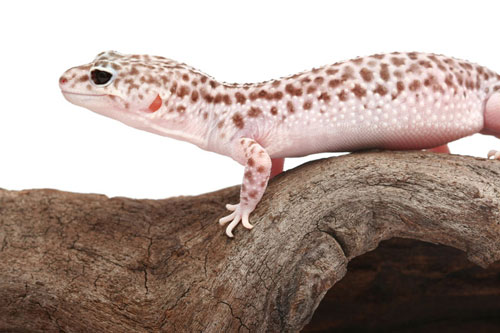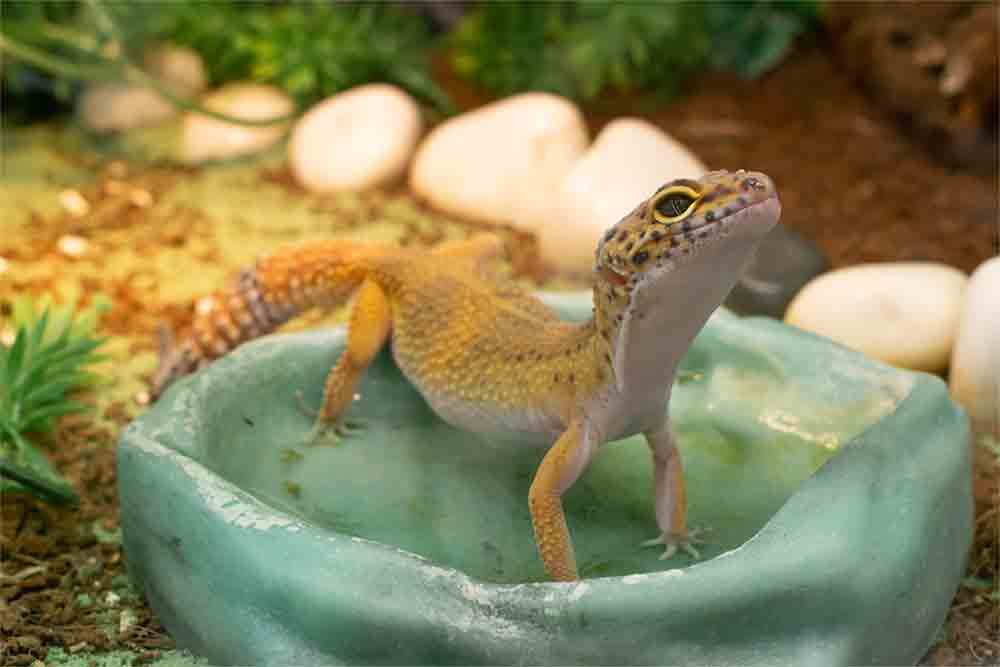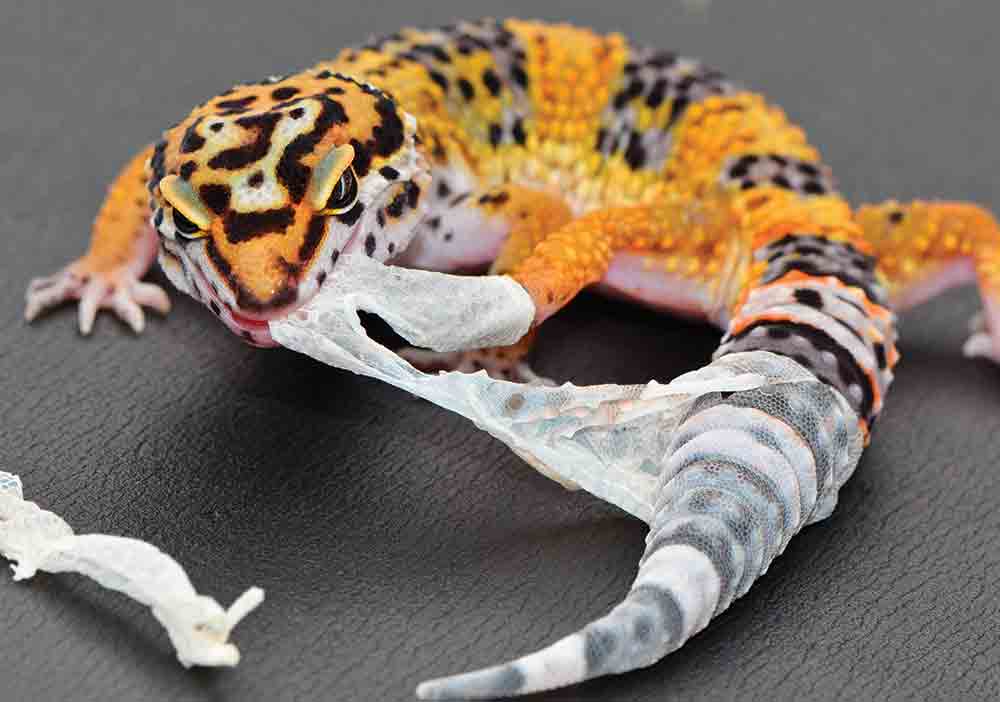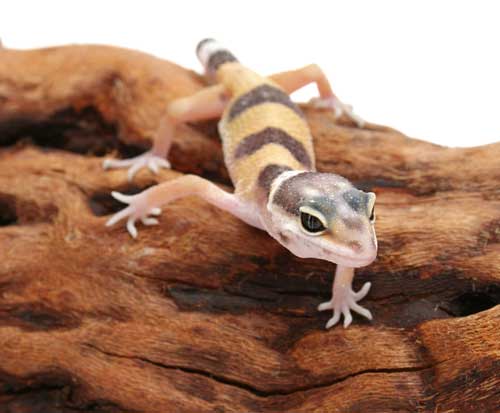Care sheet for the leopard gecko lizard (Eublepharis macularius).
Updated November 24, 2023
Leopard Gecko (Eublepharis macularius)
The leopard gecko (Eublepharis macularius) lizard has been captive bred in the United States for more than 30 years and is one of the most commonly kept lizards today. These hardy saurians come in a variety of colors, patterns and sizes. This is a great species for the home. Imagine a lizard that can vocalize and wash an eye with its tongue with ease. There is a friendly dinosaur in this small package.
Leopard Gecko Availability
Captive-bred leopard geckos can be found in pet stores, at reptile shows and on the Internet. Many breeders have websites where you can learn about, select and purchase healthy leopards, which range in price from $20 to $3,000. There is a huge collector market worldwide for the rarer variations of leopard geckos.
Leopard Gecko Size
Hatchlings measure 3 to 4 inches long. Adult females are typically 7 to 8 inches, and males are 8 to 10 inches. Some males of the giant bloodlines reach nearly a foot.
Leopard Gecko Life Span
Leopard geckos are long-lived compared to some reptiles. On average you can expect your gecko to live six to 10 years, but many males live 10 to 20 years. At least one male is still breeding at 27½ years of age.
Leopard Gecko Caging
A 20- to 40-gallon reptile enclosure can house one gecko while a male/female pair can be housed in a 40-gallon, from hatchling to adult size. Larger tanks tend to cause the geckos to stray away from their proper heat and hide box. Although visibility is reduced, many people use plastic storage boxes as housing. Any cage you choose should be at least 1 foot tall. Be sure to have a secure screen top on your gecko cage that will support a light fixture, provide good ventilation and keep out bothersome cats. A hide box filled with moist moss or vermiculite is needed, so your leopard gecko can shed its skin properly. This secure setting also is needed for egg laying if you plan on breeding geckos. Live or artificial plants can be added for a nice decorative touch.

Leopard geckos can live six to 10 years with males living to 20 years. Photo Credit: Gina Cioli/i5 Studio
Leopard Gecko Lighting and Temperature
The best way to heat your leopard gecko is by using an undertank heating pad or tape. These are available at any pet store or online. Heating one end of the cage is best. This allows for a temperature variation that your lizard needs. Heat rocks tend to become too hot for leopard geckos and should be avoided due to the risk of burns. For viewing, a simple low-wattage light can be placed overhead on the screen-cage top and left on 12 hours a day. (Editor’s note: Since the publishing of this care sheet, evidence has determined that leopard geckos are crepuscular shade dwellers and benefit from UVB. They are a Zone 1 animal on the Ferguson Zone for UVB. Provide a 2 to 5% UVB light with a UVI Zone range of 0.7. The UVB lamp should be about 1/2 the length of the terrarium with UVB output at 0.7 at the strong end to zero on the other end. A UVB reader will provide readings in the terrarium. Read the labels on the UVB light before you purchase to ensure it will work with your particular enclosure, as height of the enclosure and basking area will affect UVB absorption as UVB decreases with distance. Run the lights on a 12 hours on 12 hours off cycle. Replace the UVB light at the manufacturer recommendations as the UVB output degrades over time.)
The ideal temperature in the hide box is 88 to 90 degrees Fahrenheit at all times. The ambient air temperature of the room they are housed in should be above 73 degrees.
Leopard Gecko Substrate
Newspaper, pea gravel, artificial turf, flat stones or no floor covering are OK. A young or debilitated leopard gecko might consume sand or fine-particle products on the cage floor, and this could lead to intestinal impaction. Leopard geckos actually have a “bathroom” in one corner of their cages, and that area can be spot-cleaned without disrupting the entire system. Do not expose your gecko to commercial plant soils or sands that may contain fertilizer or pesticides.

Leopard geckos are one of the most popular lizards among reptile keepers. Photo by Shutterstock
Leopard Gecko Food
Live insects are a must for your gecko; they do not eat plants or veggies. The best items to use are mealworms or crickets, but you can treat your pet to waxworms or superworms once a week if you wish. Avoid feeding leopard geckos pinky mice. All insects must be first given a nutritious powdered diet for at least 12 hours before being fed to your leopard gecko. This process is called gut loading,” and it is very important to the health of your pet. Chick or hog mash is available at all feed stores, and several good commercial diets are available for this purpose, as well. Simply place the insects in a tub of gut-load diet with a piece of potato to serve as a source of water.

Leopard gecko eating its shed. Photo by Landshark/Shutterstock
Dusting your insects is one way to deliver important vitamins and minerals to your leopard gecko. Insects and the dusting powder can be placed in a plastic bag or deep tin can, and shook gently to coat the insects’ bodies. When adding the dusted insects to the cage, be sure not to let the powder get into a gecko’s eyes. Another way to give the extra powdered supplements to your gecko is to keep a small jar lid filled with vitamin-mineral powder at all times. The gecko knows how much its body needs, and it will lick up the powder accordingly.
Keepers can offer two appropriately sized insects for every inch of a leopard gecko’s total length. A meal every other day is fine. Therefore, a 4-inch-long gecko would receive eight mealworms three to four times a week. It is normal for leopard geckos to eat their shed skin.
Leopard Gecko Water
A shallow water dish with fresh water must be available at all times. It should also be stable, so it cannot be spilled. Cage substrate should be kept dry, so be careful about spillage. Make sure that young and adult leopard geckos can climb easily out of the dish you use. Vitamin drops should not be added to the water.
Leopard Gecko Handling and Temperament
In general, do not handle leopard geckos on a regular basis until they settle in and are more than 6 inches in total length. Once your gecko is large enough, it is best to sit on the floor, and let your gecko crawl through loose fingers and hand-over-hand for 10 to 15 minutes per day until they are accustomed to your touch. This taming process takes only five to seven days. Never grab or hold the gecko’s tail, or it might be dropped. Often the tail regenerates in less than 40 days.
Ron Tremper is the source for Leopard Gecko information and breeding. Please visit his site at www.LeopardGecko.com.



